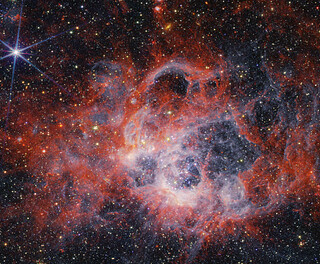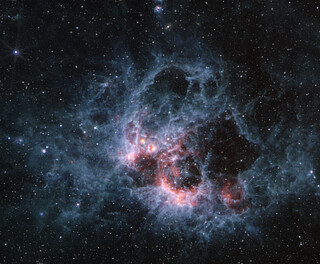Webb’s views of NGC 604
Two new images from the NASA/ESA/CSA James Webb Space Telescope showcase the star-forming region NGC 604, located in the Triangulum Galaxy (M33), 2.73 million light-years away from Earth. In these images, cavernous bubbles and stretched-out filaments of gas etch a more detailed and complete tapestry of star birth than seen in the past.
Sheltered among NGC 604’s dusty envelopes of gas are more than 200 of the hottest, most massive kinds of stars, all in the early stages of their lives. These types of stars are known as B-types and O-types, the latter of which can be more than 100 times the mass of our own Sun. It’s quite rare to find this concentration of them in the nearby Universe. In fact, there’s no similar region within our own Milky Way galaxy.
This concentration of massive stars, combined with its relatively close distance, means NGC 604 gives astronomers an opportunity to study these objects at a fascinating time early in their life.
On the left, Webb’s NIRCam (Near-Infrared Camera) shows how stellar winds from bright, hot young stars carve out cavities in surrounding gas and dust. On the right, Webb’s MIRI (Mid-Infrared Instrument) shows how large clouds of cooler gas and dust glow at mid-infrared wavelengths. In the MIRI view of NGC 604, there are noticeably fewer stars than Webb’s NIRCam image. This is because hot stars emit much less light at these wavelengths. Some of the stars seen in this image are red supergiants — stars that are cool but very large, hundreds of times the diameter of our Sun. The blue tendrils of material signify the presence of polycyclic aromatic hydrocarbons, or PAHs.
Credit:NASA, ESA, CSA, STScI
About the Images
| Id: | weic2407a | |
|---|---|---|
| Release date: | 9 March 2024, 21:30 | |
| Related releases: | weic2407 | |





